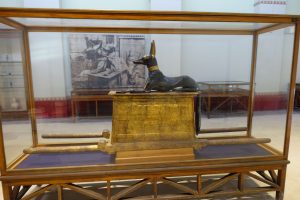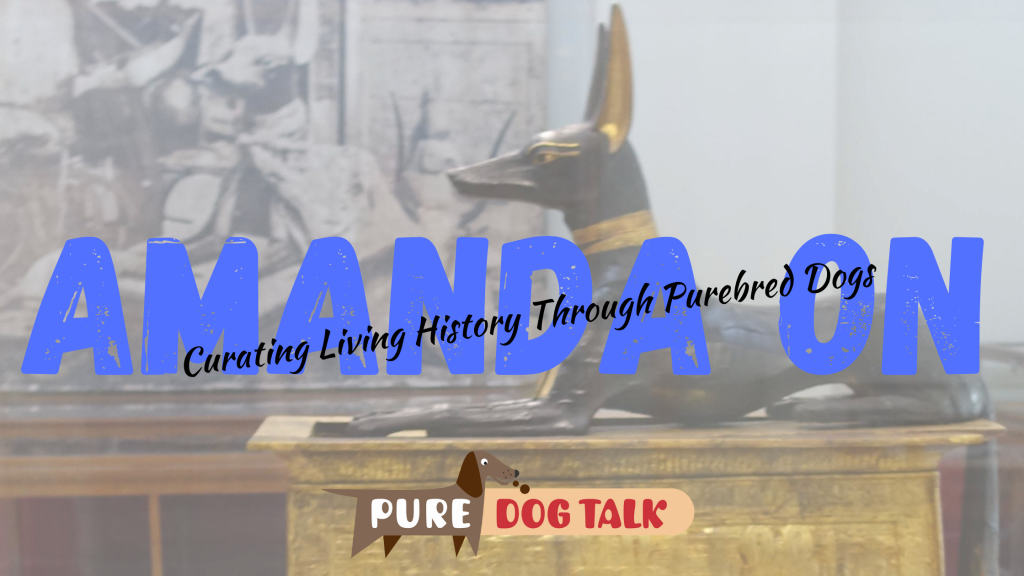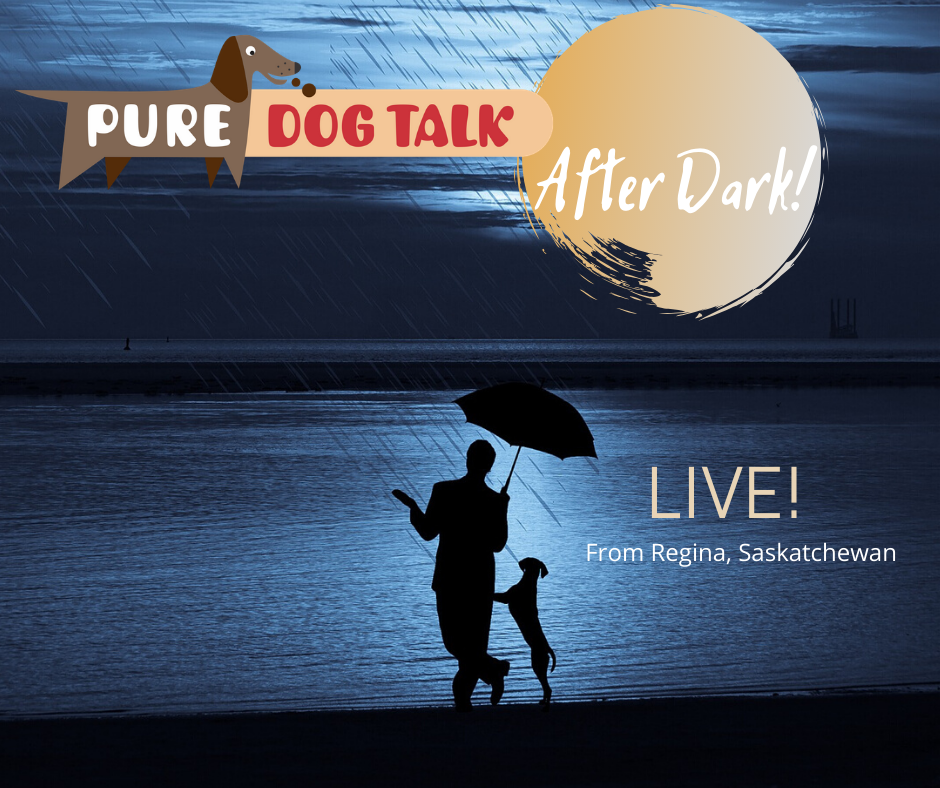469 – Curating Living History Through Purebred Dogs
Curating Living History Through Purebred Dogs
“Purebred dogs are the only living museum of mankind’s journey on Earth.” Dr. Richard Meen

The dog god Anubis at the Egyptian Museum in Cairo. Photo by Lance Woodruff
Amanda Kelly, Fwaggle Toy Manchester Terriers in Canada, and host Laura Reeves take a deep dive on the history of purebred dogs. From the Victorian era, through the Industrial Revolution to today, we discuss how and why purebred dogs developed and how preservation breeders are curating living history through purebred dogs.
“I think that (Meen’s quote) is such a profound statement,” Kelly said. “Because it speaks to two things for me and there’s a tension between them. One is, it talks about the reasons why preservation is so important. We preserve our breeds because we love them, which is always going to be the number one reason that we do anything in the dog world. But there’s a broader purpose. There’s a broader service to society in preserving some of these breeds, particularly the very old ones. In that we are the ones who are maintaining this living museum.
“We are the ones who can show to a 10-year-old interested in ancient Egypt a dog that maybe looks exactly like a dog that sat next to Cleopatra… We can talk about the history of the country. And we can put a living artifact in front of people.
“I think the importance of artifacts and touch points that allow people to not just read above something, but to have an emotional and physical connection, is maybe a little bit more present for me when it comes to dogs, because I think that as a tool we are telling the story of our history on this Earth.
“Dogs have a really particular way of doing that because they speak not only to the things that they did for us, which in turn tells us about the way that we lived in different times and in different places in our history, they also allow us to actually feel a connection to that time you just can’t get through words on a page.
“What Doctor Meen said also speaks to the concept of evolution… all of these animals, whether they were developed in one part of the world or another part of the world, they all come from a place. We didn’t arrive in 2000 with 400 plus dog breeds that just magically rained down from on high. These were purposely developed animals in whatever area of the world and for whatever reason they were developed.
“They reflect the hand of humans who were the ones that were choosing them. Whether we’re talking about 500 years ago when they were being selected for behaviors that helped people actually live. I mean, people relied on these animals in order to be able to put food on the table.
“So, whether you’re talking about that or you’re talking about perhaps a companion dog that was developed by the Victorians because it was cute sitting on a pillow, it doesn’t make any difference why it was developed. But as part of that living museum. We are also reflecting that we have developed these animals through this concept that I talked about earlier, which is this idea of evolution with intent.”
“So 2021 is a whole lot different than 1821 or 1921. And it has different things that are important to the people in this society. And I think it is noteworthy that dogs, in some format or another, are still one of those things. They are one of the through lines of all of our history,” Laura noted.
“The concept of preservation breeding is a really important one,” Amanda added. “And thinking about what is it that we’re preserving and how we do that most effectively.
“But I think as groups of breeders we have to think more about where our breeds are going to be in 50 years and how we’re going to make sure that they’re still here. And that may require us to make hard choices. It may require us to make backup plans and to plan breedings that have alternate agendas other than producing your next best in show winner and those are hard things.
“If you’ve devoted your entire life to a breed. And the difference is that you can’t crop it or you can’t dock it. Or perhaps both, depending on your breed. Would you be willing to not only not have that breed in your life? But to actually see it disappear completely because of that.”
I don’t know the answer, but that is the question.
370 – How Judges Decide Placements: Conformation and Obedience
How Judges Decide Placements: Conformation and Obedience
Part two of our panel discussion at the Regina Kennel and Obedience Club’s Prairie Christmas Dog Show with an international coterie of judges focuses on: the details of breed type and presentation, exercising patience, judging uncropped and undocked dogs, legislation and growing our sport.
From Sue-Ellyn Rempel on making a final placement:
“I guess for me general outline for starters and then movement is very breed specific for me. So I kind of go by that…. they have to scream German Shepherd … a lot of times we get … a class of 5 and they’re all generic … they get from point A to point B really well they stack and their moderately angulated like the breed should be but they’re not smooth, they don’t flow in the correct way…. like the make and shape difference in the shape from a Great Dane to a whippet… whippets you want the beautiful soft gentle curves… that’s gotta hit me right away… when I look at them, that they are the right shape and then when they take the steps, that puts the picture together for me.”
From Frances Smith on what she sees in the ring:
“I find it very important to reward the breed specific, unique characteristics because (there are) a lot of generic dogs, too many generic dogs, too many dogs that finished championships that really… shouldn’t be … because supposedly a champion is a superior specimen of the breed. So it’s up to us to keep the quality and to reward those breed specific points because without them we lose those identifying points of each breed. I want to add another thing that’s very important, temperament, which is also one of the 6 points in type, … because the temperament has to belong to the breed …without the correct temperament I don’t care if a dog is extremely showy, he’s gotta have the breed’s temperament. I don’t want just a fancy dancer in the ring … I don’t want to see a dog jumping and doing things that aren’t typical of his breed.”
From Diana McKenzie on changes she’s seen in her time in the sport:
“There’s been a ton of changes over the years in obedience … even training methods OK these days are so different from what they were 20-30 years ago. … unfortunately a lot of people go into obedience and they think it’s easy. OK rally is easy, yes. Obedience is not easy. It is not a given and it’s something that you as a handler have to work with your dog to attain a nice working relationship with and train the behaviors. Rally is easy to me, I shouldn’t say it’s easy to everyone, but it’s a wonderful venue to train with your dog and teach your dog in a positive way how to move its rear end and be aware of its rear end movement which a lot of people don’t do. (That’s) just one small thing that you can think of to work with them. Fronts, finishes, drops, all of that are in rally obedience as well as the heeling, so when you see a team in rally obedience and they are true team it’s wonderful. … in obedience … over the years training methods are changing. Corrections, harsh corrections, are becoming less and less used (people are) more into the purely positive methods. That’s wonderful, if you know how to do it properly. A lot of people don’t, therefore they get a brat in a dog that goes in (and says) “I don’t have to ’cause there are no consequences…”


